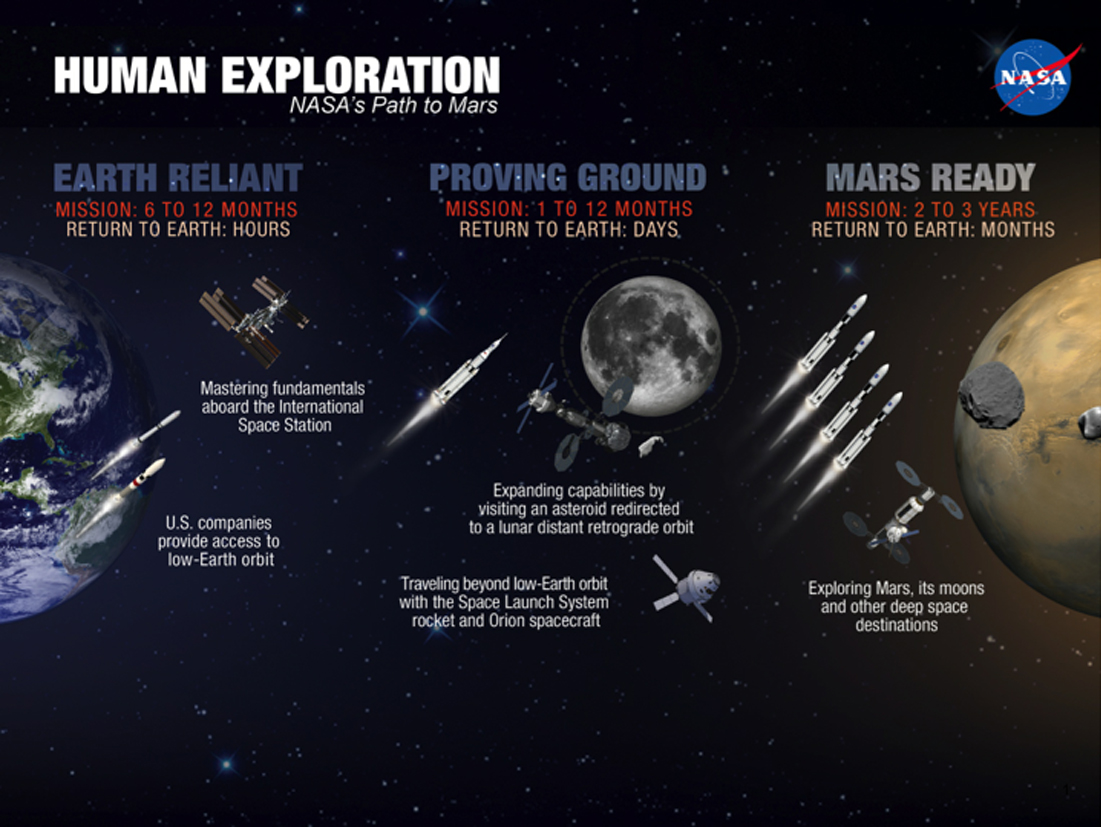The Path to Mars — Risk Informed Decision Making
SMA News May 2014
Message from the Deputy Chief, Safety and Mission Assurance

NASA's stepping-stone approach to sending humans to Mars involves continued research on the Space Station, testing new capabilities beyond the moon, exploring an asteroid and ultimately sending a crewed mission to the Red Planet.
Risk management is an integral aspect of virtually every challenging human endeavor. The foundation of a successful risk management program is Risk-Informed Decision Making (RIDM). Given the complex concepts that human flight to Mars encapsulates, RIDM will be critical to program and project success. RIDM helps to ensure that decisions between alternatives are made with an awareness of the risks associated with each, thereby helping to prevent late design changes, which can be key drivers of risk, cost overruns, schedule delays and cancellation.
The RIDM process consists of three parts: (1) Identification of decision alternatives, recognizing opportunities where they arise, and considering a sufficient number and diversity of performance measures to constitute a comprehensive set for decision-making purposes; (2) Risk analysis of decision alternatives; (3) Selection of a decision alternative informed by (not solely based on) risk analysis results. Once a decision alternative has been selected for implementation, the performance measure values that informed its selection are used to develop the baseline performance requirements that are the focus of continuous risk management (Ref. NASA/SP-2011-3422).
Most project cost-saving opportunities occur in the definition, planning and early design phases of a project. RIDM is conducted in many different venues based on the management processes of the implementing organizational unit. These include boards and panels, Authority-to-Proceed milestones, Safety Review Boards, Risk Reviews, Engineering Design and Operations Planning decision forums, Configuration Management processes, and commit-to-flight reviews, among others. The RIDM process helps us respond to some of the primary issues that have derailed programs in the past: namely (1) the “mismatch” between stakeholder expectations and the actual resources required to meet them; (2) the miscomprehension of the risk that a decision-maker is accepting when making commitments to stakeholders; and (3) the under-appreciation in considering the respective risks associated with competing alternatives.
Recently I had the opportunity to participate in a University of Maryland symposium on risk and reliability. In this presentation I discussed how RIDM would be an important component of our future. Attached are the charts I presented at that conference, as well as a recent chart presented by the administrator on our agency's path to Mars.
We continue to look towards our Safety and Mission Assurance community across the agency to be active, engaged and knowledgeable as we make the risk-informed decisions necessary to support our bold human missions to an asteroid and to Mars.
I hope you enjoy this issue of SMA News. Terry and I invite you to use SMA News to share information as well. Tell us about your staff or your co-workers' accomplishments. What are your success stories, and what hard but valuable lessons have you learned that could benefit others?
Please tell us what information you'd like to see in the future issues. Send your feedback and ideas for consideration to NASA-SMA@mail.nasa.gov. We look forward to hearing from you.
Sincerely,
Tom Whitmeyer
Deputy Chief, Safety and Mission Assurance
Download Presentation
Watch the Event
Additional Links
NASA Exploration Forum Details Human Path to Mars
Presentations From the Event
Current and Future Robotic Exploration of Mars — John Grunsfeld, Associate Adminstrator, Science Mission Directorate
NASA's Human Path to Mars — William Gerstenmaier, Associate Adminstrator, Human Exploration and Operations Mission Directorate
The International Space Station, Exploration and the Commercial Development of LEO — Sam Scimemi, Director, International Space Station
Commercial Space In Low-Earth Orbit — Phil McAlister, Director, Commercial Spaceflight Development
Orion, Space Launch System, and Ground Systems Development and Operations — Dan Dumbacher, Deputy Associate Administrator, Exploration Systems
Asteroid Redirect Mission — Michele Gates, Senior Technicial Advisor, Human Exploration and Operations
Evolvable Mars Campaign — Jason Crusan, Director, Advanced Exploration Systems
Current and Future Technology Work — Randy Lillard, Program Executive for Technology Demonstration Missions, Space Technology Mission Directorate
Benefits to Science and Technology Communities From These Endeavors — Ellen Stofan, Chief Scientist and David Miller, Chief Technologist